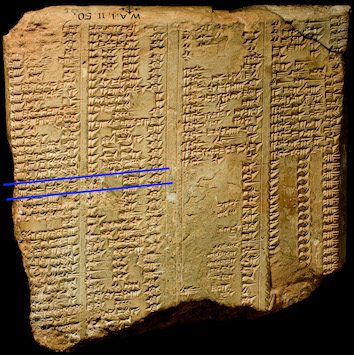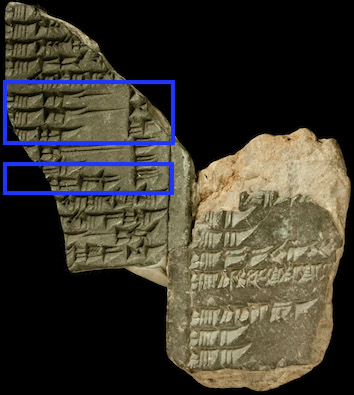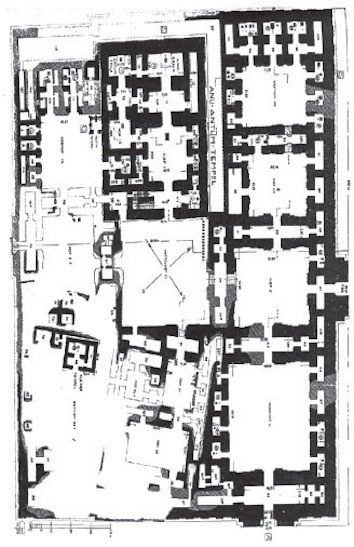Temples, Shrines, and Ziggurats of Uruk

Several first-millennium-BC lists of temples and ziggurats preserve the Sumerian names of religious structures at Uruk (Sumerian Unug; modern Warka; biblical Erech; Greek Orchoi), a large and important southern Mesopotamian city situated ca. 15 km east of the modern city of as-Samāwa and about 12 km east of the present course of the Euphrates River. Those aforementioned texts mention that Eanna and Egiparimin were the temple and ziggurat of the goddess Ištar (in her manifestation as Bēlet-Eanna, "the (Divine) Lady of Eanna"). Unfortunately, the relevant passages of those same texts recording information about Uruk's other divine patron, the sky-god Anu, are not preserved. Numerous other texts — including epics, hymns, liturgies, myths, prayers, and royal inscriptions — record the names of many different temples and shrines at Uruk, most of which are listed below.

Reverse of K 02053a + K 04337, col. iv of which contains the "Kuyunjik Ziggurat List." The name of Ištar's ziggurat at Uruk, Egiparimin, is mentioned in col. iv 20. Image adapted from the CDLI.
Alphabetical list of temples at Uruk
- Baramah: a shrine (or epithet) of the ziggurat of the god Anu
- Baranamlugala: seat of the god Anu in the cella of the bīt rēš
- bīt rēš: temple of the god Anu and the goddess Antu
- Eanki: sanctuary of the god Anu
- Eanna: temple of the goddess Ištar
- Edaimin: sanctuary of the goddess Ištar
- Edusaggara: sanctuary of the goddess Bēlet-ṣēri
- Edumununa: temple of the god Sîn
- Eʾešgal: temple of the goddesses Ištar and Nanāya
- Egalankia: shrine of the god Anu (and/or the goddess Ištar)
- Egaledin: a temple
- Egalhalhal: a temple
- Egalmah: temple of the goddess Ninisinanna
- Egašanana: cella of the goddess Antu in the bīt rēš
- Egeštumah[...]summu: temple of the god Ea
- Egeštunissaba: shrine of the goddess Nissaba
- Egigunu: a sanctuary
- Egišunugal: a sanctuary
- Egipar: part of Eanna occupied by the en-priest of the goddess Ištar
- Egiparana: temple of the en-priest of the goddess Ištar
- Egiparimin(a/bi): ziggurat of the goddess Ištar
- Egubiduga: socle of the god Papsukkal in the bīt rēš of the god Anu
- Ehenuna: temple of the god Adad
- Ehiliana: cella of the goddess Nanāya in Eanna
- Ehilidiriga: seat of the goddess Nanāya
- Ehilikuga: bed chamber of the goddess Nanāya
- E.IG.halanki: a temple
- Eigimin: shrine (or epithet) of Eanna
- EkakešHU.HU: socle of the god Papsukkal in the bīt rēš of the god Anu
- Ekiridilibad: sanctuary of the goddess Bēlet-ṣēri
- Elilla: a shrine
- Emelamana: seat of the god Šamaš
- Emeteʾera: temple of the god Nergal
- Emeurur: temple of the goddess Nanāya
- Egihallake: a temple
- Enamtara: part of Eanna
- Enamena: cella of the god Anu in the bīt rēš
- Enir: bed chamber of the goddess Antu in the bīt rēš of the god Anu
- Enirgalana: cella of the goddess Ištar
- Enirmah-kiuzebbamu: a bed chamber
- Epapah: cella of the god Anu and the goddess Ištar
- Esaggianidu: temple of the god Adad
- Esagil: temple of the goddess Ištar of Zabalam
- Esusugara: temple of the goddess Supalītu (Ištar of Zabalam)
- Ešara: ziggurat of the bīt rēš of the god Anu
- Ešlilidiriga: seat of the goddess Antu as Ninzalle
- Ešmah: part of the bīt rēš of the god Anu
- Eugalgimkihuš[...]: temple of the god Adad
- Eubimin: part of by-name of Eanna
- Eulmaš: shrine of the god Anu and the goddess Ištar
- Ezalaga: a bīt hilṣi
- E[...]ku: sanctuary of the goddess Ištar
- Giparku: temple of the en-priestess of the god Lugalbanda
- Kiagakuga: socle of the god Ea in the bīt rēš of the god Anu
- Kiagazida: socle of the god Enlil in the bīt rēš of the god Anu
- Kisagar: seat of the deity Etalak
- Kišenšena: seat of the goddess Ištar
- Kišu: part of the temple complex
- Kitušinimdugala: seat of the deity Zannaru
- Kitušsilima: seat of the Daughters of Uruk
- Kiunuga: seat of the goddess Ištar
- Kizalaga: a shrine in the bīt rēš of the god Anu
- Ubšuʾukkina: Court of Assembly in the bīt rēš of the god Anu
- Zaduagubu: a shrine
- Zaduazida: a shrine

Reverse of K 12024 + K 12035, a small fragment of a clay tablet containing the "Canonical Temple List." Ištar's temples (Eanna and Eʾešgal) and ziggurat (Egiparimin) at Uruk are mentioned in lines 6´–8´ and 11´. Image adapted from the CDLI.

Plan of the bīt rēš (Rēš temple). Image from Davide Salaris, "A Case of Religious Architecture in Elymais: The Tetrastyle Temple of Bard-e Neshandeh," fig, 12. Brill online.
At the heart of Uruk — which developed from the joining of two earlier mounds — were the Eanna and Anu districts. The former was dedicated to the goddess Inanna/Ištar, was walled off from the rest of city, and contained several buildings, workshops, while the latter consisted of a single massive terrace and was dedicated to the god An/Anu. Until the fifth century BC, Eanna was Uruk's principal temple. After that time, the local pantheon was reorganized and the sky-god Anu and his consort Antu supplanted Ištar as the city's principal divine patrons. In the Seleucid Period, the massive bīt rēš (Rēš Temple) and Eʾešgal (or possibly called Eirigal) temples dominated the landscape. Several texts dealing with the New Year's Festival from the Seleucid Period record details about the Urukian New Year's festival.
At the present time, the only temple discussed on BTMAo is Ištar's temple Eanna. In due course, the site will provide information about the Rēš temple and Eʾešgal.
Banner image: visualization of principal temples of Uruk during the Seleucid Period overlaid on a satellite image of the site (left); photograph of the White Temple and ziggurat (center); and reconstruction of the Rēš Temple during the Seleucid Period (right). The left and right images are from the Uruk Visualisation Project (© artefacts-berlin.de) and the center image is from the Madain Project.
Jamie Novotny
Jamie Novotny, 'Temples, Shrines, and Ziggurats of Uruk', Babylonian Temples and Monumental Architecture online (BTMAo), The BTMAo Project, a sub-project of MOCCI, [http://oracc.org/btmao/Uruk/]